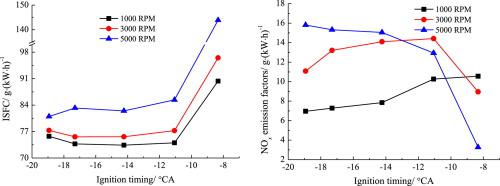Our official English website, www.x-mol.net, welcomes your
feedback! (Note: you will need to create a separate account there.)
Three-dimensional numerical simulations on the effect of ignition timing on combustion characteristics, nitrogen oxides emissions, and energy loss of a hydrogen fuelled opposed rotary piston engine over wide open throttle conditions
Fuel ( IF 6.7 ) Pub Date : 2021-03-01 , DOI: 10.1016/j.fuel.2020.119722 Jianbing Gao , Guohong Tian , Chaochen Ma , Shikai Xing , Liyong Huang
Fuel ( IF 6.7 ) Pub Date : 2021-03-01 , DOI: 10.1016/j.fuel.2020.119722 Jianbing Gao , Guohong Tian , Chaochen Ma , Shikai Xing , Liyong Huang

|
Abstract Opposed rotary piston (ORP) engines have advantages of high power density, few moving parts, and smooth operations, which makes ORP engines as potential power sources for hybrid vehicles and range extended electric vehicles. Ignition timing significantly affects the performance of spark ignition engines including fuel economy and emission factors. In this paper, the effect of ignition timing on the engine performance was investigated using a three-dimensional numerical simulation method. The results indicated that crank angle corresponding to the peak in-cylinder pressure over the ignition timing of −8.2° crank angle (CA) was advanced compared with other cases having earlier ignition timing; however, the crank angle of peak heat release rates were retarded. Start of combustion was delayed by retarding the ignition timing and increasing engine speed; combustion duration over the ignition timing of −18.9° CA ~ −11.1° CA changed slightly for individual engine speed. Indicated specific fuel consumption (ISFC), being hardly dependent on the ignition timing, was less than 74 g/(kW·h) over the ignition timing of −17.3° CA ~ −11.1° CA, where indicated thermal efficiency was approximately 41%, 39% and 35% for 1000 RPM, 3000 RPM and 5000 RPM respectively. When ignition timing was later than −11.1° CA, ISFC and indicated thermal efficiency were deteriorated seriously. Nitrogen oxides (NOx) emission factors increased with engine speed over early ignition timing; however, they were inverse for late ignition cases. Higher engine speed and retarded ignition timing led to higher percentage of exhaust energy in fuel chemical energy.
中文翻译:

氢燃料对置旋转活塞发动机在节气门全开条件下点火正时对燃烧特性、氮氧化物排放和能量损失影响的三维数值模拟
摘要 对置旋转活塞(ORP)发动机具有功率密度高、运动部件少、运行平稳等优点,使其成为混合动力汽车和增程式电动汽车的潜在动力源。点火正时显着影响火花点火发动机的性能,包括燃料经济性和排放因子。本文采用三维数值模拟方法研究了点火正时对发动机性能的影响。结果表明,与点火正时较早的其他情况相比,在-8.2°曲柄角(CA)的点火正时内对应于峰值缸内压力的曲柄转角提前;然而,峰值热释放率的曲柄角被延迟。通过延迟点火正时和提高发动机转速来延迟燃烧开始;-18.9° CA ~ -11.1° CA 点火正时的燃烧持续时间因发动机转速而略有变化。在-17.3° CA ~ -11.1° CA 的点火正时,指示比燃料消耗 (ISFC) 几乎不依赖于点火正时,小于 74 g/(kW·h),其中指示热效率约为 41% 、1000 RPM、3000 RPM 和 5000 RPM 分别为 39% 和 35%。当点火时间晚于-11.1°CA时,ISFC和指示热效率严重恶化。氮氧化物 (NOx) 排放因子随着发动机转速在点火正时提前而增加;然而,对于延迟点火的情况,它们是相反的。
更新日期:2021-03-01
中文翻译:

氢燃料对置旋转活塞发动机在节气门全开条件下点火正时对燃烧特性、氮氧化物排放和能量损失影响的三维数值模拟
摘要 对置旋转活塞(ORP)发动机具有功率密度高、运动部件少、运行平稳等优点,使其成为混合动力汽车和增程式电动汽车的潜在动力源。点火正时显着影响火花点火发动机的性能,包括燃料经济性和排放因子。本文采用三维数值模拟方法研究了点火正时对发动机性能的影响。结果表明,与点火正时较早的其他情况相比,在-8.2°曲柄角(CA)的点火正时内对应于峰值缸内压力的曲柄转角提前;然而,峰值热释放率的曲柄角被延迟。通过延迟点火正时和提高发动机转速来延迟燃烧开始;-18.9° CA ~ -11.1° CA 点火正时的燃烧持续时间因发动机转速而略有变化。在-17.3° CA ~ -11.1° CA 的点火正时,指示比燃料消耗 (ISFC) 几乎不依赖于点火正时,小于 74 g/(kW·h),其中指示热效率约为 41% 、1000 RPM、3000 RPM 和 5000 RPM 分别为 39% 和 35%。当点火时间晚于-11.1°CA时,ISFC和指示热效率严重恶化。氮氧化物 (NOx) 排放因子随着发动机转速在点火正时提前而增加;然而,对于延迟点火的情况,它们是相反的。











































 京公网安备 11010802027423号
京公网安备 11010802027423号